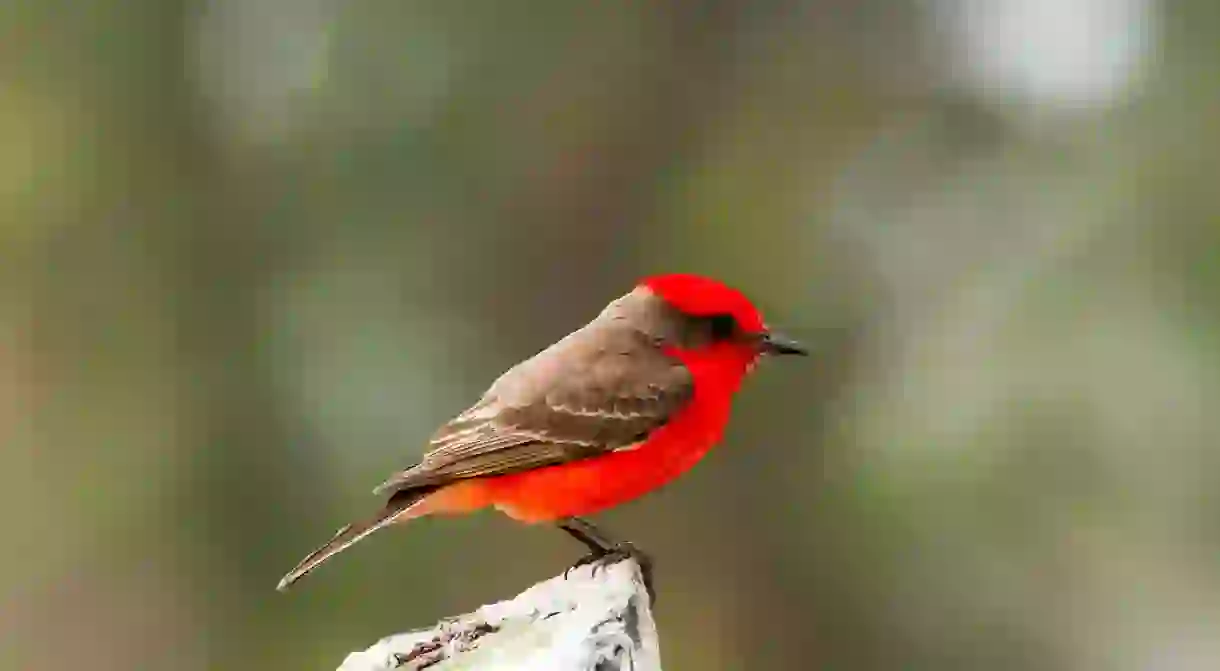The Best Birdwatching Spots in and Around Quito

Ecuador is home to 1,620 species of birds, an incredible fact for a country that is the size of the state of Minnesota. Quito makes a great base to see many species because it is close to a wide variety of birding habitat. Here are a few best birdwatching destinations that lie close to Quito.
Parks and gardens
Parque Metropolitano
The Parque Metropolitano stands atop a broad hilltop bordering the northeast side of Quito. The park provides views across the wide valley to snow-covered mountain peaks such as Cayambe and Antisana, while the protected eucalyptus forest and the manicured gardens provide excellent habitat for birds living in and around the city. Near the park’s main office is a small garden full of blooming fuschias that attract the black-tailed trainbearer hummingbird. The nearby fir trees are home to many sparkling violetears, whose high-pitched chirping can be heard at all hours of the day. The forested trails protect key habitat for many species of tanagers, finches, wrens, and sparrows.
Parque Metropolitano, en el, Guanguiltagua, Quito, Ecuador, +593 99 707 2356

San Jorge de Quito
The lodge of San Jorge de Quito sits just outside the capital city. Hummingbirds flock to the beautifully manicured gardens, while woodpeckers, grosbeaks, seed-finches and the like are attracted to nearby forested tracts. Miles of trails pass through secondary cloud forest to reach the high paramo of Pichincha.

Alambi
On the road from Quito to Mindo is a small turnoff leading to the small community of Tandayapa. On the corner is a tiny property, the historic home known as Alambi. Their garden is full of birds! Several feeders attract some brilliant species of hummingbirds, including all three species of violetears, and the plantain feeders consistently attract barbets, tanagers, woodpeckers, and brush finches.

Cloud Forest
Reserva Yanacocha
The Jocotoco Foundation runs a small nature reserve on the west side of the Pichincha Volcano known as the Yanacocha Reserve. With miles of hiking trails through primary cloud forest and excellent views of the mountain range heading towards the coast, Yanacocha is a birdwatcher’s paradise. Masked trogons, barred fruiteaters, several species of tanagers, and dozens of hummingbirds are all visible while hiking this wonderful reserve.

Tandayapa
Tandayapa is the epicenter of a birdwatching paradise. Local lodges provide gardens with hummingbird feeders and miles of trails to better observe some of the shyer cloud forest species, such as trogons, quetzals, and tanagers who prefer wild foraging to plantain feeders. Most offer a day-use fee, making this a great day trip option from Quito.

Guango Lodge
Guango Lodge is only a short drive from Quito, and visitors can combine it with a visit to the hot springs in Papallacta. They have a hummingbird garden tucked in between the small parking lot and the main lodge. They also have miles of hiking trails through different habitats, increasing your chance of seeing a wide variety of birds.
Guango Lodge, Ecuador, +593 2-289-1880

High Paramo
Teleferico
The popular cable car that takes passengers up the slopes of Pichincha, providing excellent views of the entire city of Quito nestled into its long, narrow valley, is the best method of transportation to take you to the high paramo. This high mountain Andean habitat is home to many raptors, some small ground-loving birds, and the beautiful Ecuadorian hillstar hummingbird. Although not common, it is possible to see an Andean condor fly overhead.

Reserva Antisanilla
On the way to Lago Mica is a small nature reserve, the Reserva Antisanilla, operated by the Jocotoco Foundation. This single place is the best in all of Ecuador to see Andean condors. The vista from the viewing platform just off the main road includes seasonal waterfalls, rocky mountain faces, and prime nesting habitat for this majestic bird. In 2017, the rare Andean spectacled bear was spotted on the reserve grounds.
Reserva Antisanilla, Pintag-Lago Mica Road, Ecuador, +593 2-250-5212

Antisana Conservation Area
The boggy wetlands that lie along the road within the Antisana Conservation Area are full of birds, especially carunculated caracaras. Other wetland species, such as the Andean black-faced ibis, favor this area as well. Keep a sharp eye open as Andean condors use this area as a fly-by in between their nests and their scavenging grounds.

Cotopaxi National Park
The Laguna Limpiopungo is a seasonal lake at Cotopaxi National Park that grows in size during the rainy season. Andean gulls, which nest on small islands in the middle of the lake, are only some of the water-loving bird species seen year-round. Look for the Andean coot, Andean teal, greater and lesser yellowlegs, several sandpipers, and the well-camouflaged Andean lapwing.
Cotopaxi National Park, Ecuador, +593 2-398-7600

Microclimate locations
Pululahua Geobotanical Reserve
This extinct volcanic crater is the largest, inhabited crater in South America. In an attempt to protect a unique microclimate, a caldera that experiences a “cloud of water” every afternoon, the government declared the zone protected. People have farmed here for more than 500 years, and the combination of farmland with scrub-covered mountainsides provides great habitat for birds such as the white-tipped dove, the Andean emerald hummingbird, the blackish tapaculo, the cinnamon flycatcher, and the southern yellow grosbeak.

Parque Jerusalem
Parque Jerusalem is a regional park created to protect a small corner of the dry forest unique to this part of the Andes. Although this destination is only an hour outside of Quito, it feels like an entirely different location. The park only receives a scant centimeter or two of rainfall a year, and its grounds are home to the giant hummingbird, blue-and-yellow tanagers, the eared dove, and the stunning vermilion flycatcher.














